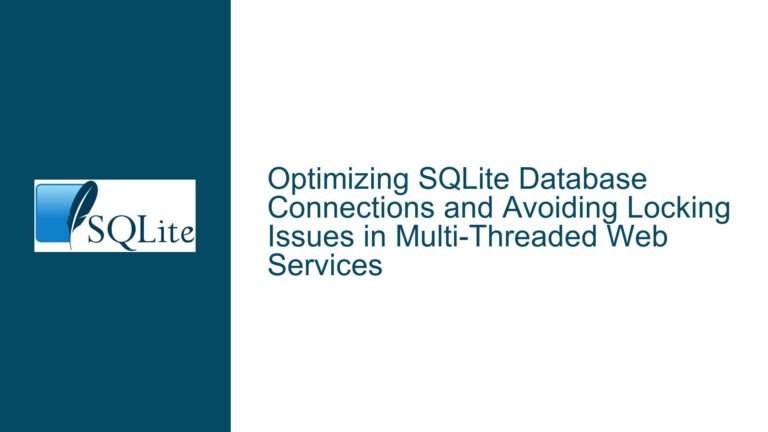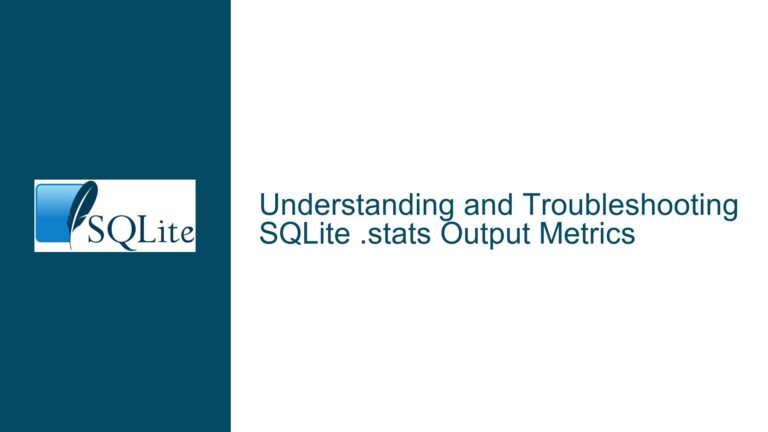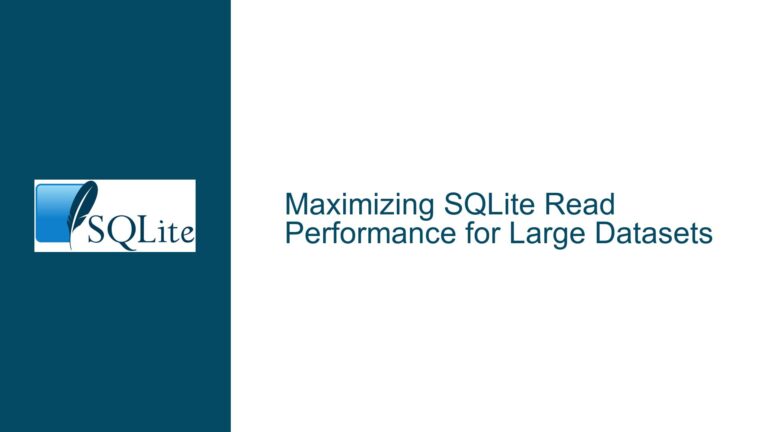Blocking VFS Support in SQLite for Windows: Challenges and Solutions
Understanding the Need for Blocking VFS in SQLite
The core issue revolves around the desire to implement blocking behavior in SQLite’s Virtual File System (VFS) layer, particularly for Windows environments. The goal is to replace the default non-blocking behavior, which returns SQLITE_BUSY when a resource is locked, with a blocking mechanism that waits for the resource to become available. This is especially critical in high-performance, parallel environments where multiple readers and writers are contending for access to the same database.
In the default configuration, SQLite uses non-blocking locks, meaning that if a lock cannot be acquired immediately, the operation fails with SQLITE_BUSY. This behavior is implemented using the LOCKFILE_FAIL_IMMEDIATELY flag in Windows’ LockFileEx function. While this approach is simple and avoids deadlocks, it can lead to inefficiencies in high-concurrency scenarios, as threads must repeatedly retry acquiring the lock, potentially leading to CPU contention and reduced throughput.
The discussion highlights two primary scenarios: non-WAL (Write-Ahead Logging) mode and WAL mode. In non-WAL mode, it appears feasible to implement blocking behavior by modifying the VFS layer to use blocking calls instead of non-blocking ones. However, in WAL mode, the situation is more complex due to the nature of shared memory locks (ShmLock), which are used to manage concurrent access to the WAL file. Some of these locks are "probes" that must fail immediately if the lock is not available, even in single-threaded scenarios. This raises questions about the feasibility of implementing blocking behavior in WAL mode without violating the existing contract.
Challenges in Implementing Blocking VFS for Windows
The challenges in implementing blocking VFS support for SQLite on Windows are multifaceted. First, there is the issue of compatibility with existing SQLite behavior. SQLite’s design assumes that locks are non-blocking, and changing this assumption could have far-reaching consequences, particularly in WAL mode. For example, in WAL mode, certain operations rely on the ability to probe locks without waiting, and introducing blocking behavior could lead to deadlocks or other unexpected behavior.
Second, there is the technical challenge of implementing blocking locks on Windows. While Windows’ LockFileEx function supports blocking behavior through the LOCKFILE_EXCLUSIVE_LOCK flag, using this flag requires that the file handle be opened with FILE_FLAG_OVERLAPPED to enable asynchronous I/O. This, in turn, necessitates changes to the VFS layer to handle asynchronous I/O operations, which is not a trivial task. Additionally, the shared memory handling in WAL mode is implemented in SQLite’s core and is not delegated to the VFS layer, further complicating the implementation.
Third, there is the issue of fairness in lock acquisition. In high-concurrency scenarios, the current non-blocking approach can lead to thread starvation, where some threads are repeatedly unable to acquire locks while others succeed. Implementing blocking behavior with proper fairness guarantees would require careful consideration of the underlying operating system’s locking mechanisms and how they interact with SQLite’s concurrency model.
Solutions and Recommendations for Blocking VFS Implementation
To address these challenges, several approaches can be considered. For non-WAL mode, the most straightforward solution is to modify the VFS layer to use blocking calls instead of non-blocking ones. This can be achieved by defining SQLITE_LOCKFILEEX_FLAGS without the LOCKFILE_FAIL_IMMEDIATELY flag, allowing LockFileEx to block until the lock is acquired. However, this approach should be thoroughly tested to ensure that it does not introduce deadlocks or other issues, particularly in scenarios with multiple threads contending for the same resource.
For WAL mode, the situation is more complex due to the need for immediate failure in certain lock probes. One potential solution is to introduce a hybrid approach, where blocking behavior is used for most locks but immediate failure is retained for specific probes. This would require careful modification of the VFS layer and possibly the core SQLite code to distinguish between different types of locks and handle them appropriately.
Another approach is to leverage the experimental support for SQLITE_ENABLE_SETLK_TIMEOUT, which allows for blocking with a timeout. This feature is currently available on a branch and provides a middle ground between non-blocking and fully blocking behavior. By using a timeout, it is possible to avoid indefinite blocking while still reducing the frequency of SQLITE_BUSY errors. However, this approach requires further development and testing to ensure compatibility with Windows and to address any performance or fairness issues.
Finally, for those willing to invest in a more comprehensive solution, implementing a custom VFS with full support for asynchronous I/O and blocking locks is an option. This would involve opening file handles with FILE_FLAG_OVERLAPPED and modifying the VFS layer to handle asynchronous operations. While this approach is the most complex, it offers the greatest flexibility and control over the locking behavior, potentially leading to significant performance improvements in high-concurrency scenarios.
In conclusion, implementing blocking VFS support in SQLite for Windows is a challenging but achievable goal. By carefully considering the trade-offs and leveraging existing experimental features, it is possible to develop a solution that meets the performance and concurrency requirements of modern applications. However, thorough testing and careful integration with SQLite’s core functionality are essential to ensure that the solution is robust and reliable.






